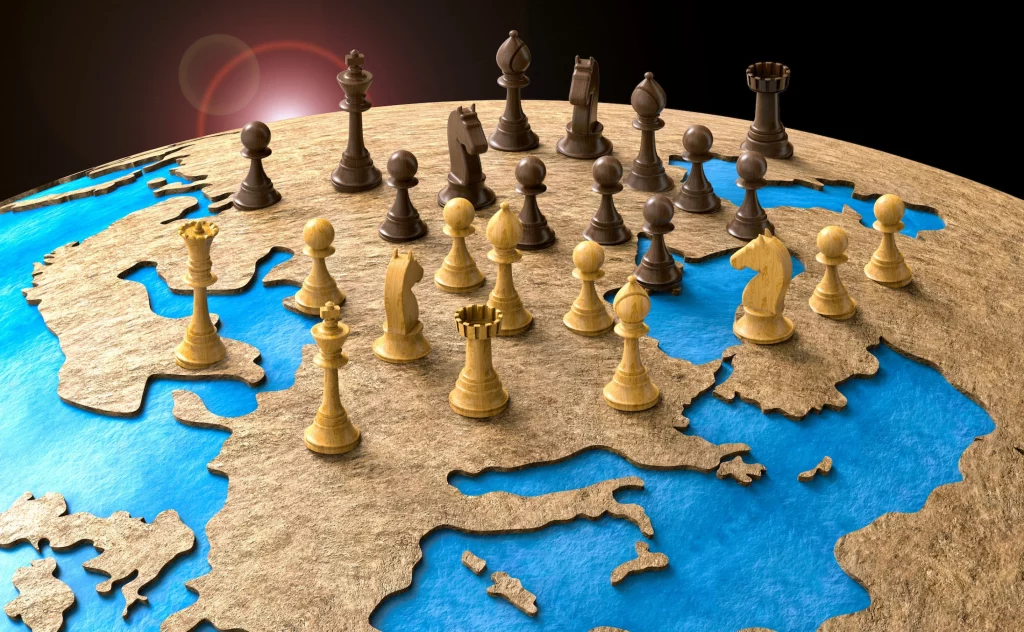Introduction: The Triangular Dynamics of Geopolitics
Geopolitics has always been shaped by material realities—resources, technology, and land. In the 21st century, the interplay between energy security, technological innovation, and territorial disputes has emerged as the primary force behind both cooperation and conflict.
This essay examines these three pillars of geopolitics, demonstrating how they intersect to influence global stability.
Part I – Energy as the Lifeblood of Geopolitics
1.1 Global Trends
- Transition from fossil fuels to renewables reshaping traditional energy dependencies.
- Oil and gas still crucial in Middle East, Russia, and Central Asia.
- Renewables (solar, wind, hydrogen) create new centers of strategic importance.
1.2 Case Studies
- Europe and Russia: The Ukraine war highlighted vulnerabilities of over-reliance on Russian gas.
- Middle East: Saudi Arabia’s Vision 2030 diversifies energy while maintaining oil dominance.
- Africa: Rising competition for cobalt, lithium, and rare earths (key for EV batteries).
1.3 Risk Predictions
- Energy transitions may spark new resource conflicts (rare earth wars).
- Petrostates may experience instability if revenues collapse.
- Competition for green technology dominance could replace oil geopolitics with battery geopolitics.
Part II – Technology as the New Battleground
2.1 Global Trends
- AI, quantum computing, and biotechnology redefine military and economic power.
- Tech sovereignty becomes a national priority (e.g., U.S.–China chip rivalry).
- Cyberspace emerges as a parallel battleground.
2.2 Case Studies
- U.S.–China tech war: Restrictions on semiconductors, 5G infrastructure, and AI tools.
- Europe: EU regulations like GDPR shaping digital governance.
- Israel: A hub of cybersecurity and military tech innovation.
2.3 Risk Predictions
- Splintered internet and digital blocs (Western vs. Chinese models).
- AI weaponization intensifying arms races.
- Rising cyberattacks destabilizing critical infrastructure globally.
Part III – Territory and Strategic Geography
3.1 Global Trends
- Borders remain central despite globalization.
- Maritime chokepoints (South China Sea, Strait of Hormuz, Arctic passages) gain importance.
- Territorial disputes linked to resources and strategic positioning.

3.2 Case Studies
- South China Sea: Disputes over islands tied to trade routes and energy reserves.
- Arctic: Melting ice opens new shipping lanes and resource competition among Russia, U.S., China.
- India–China border tensions: Himalayas as a flashpoint with strategic and symbolic value.
3.3 Risk Predictions
- Climate change exacerbates territorial disputes (water scarcity, Arctic routes).
- Militarization of strategic chokepoints could trigger great-power conflict.
- Outer space and seabed could become new “territorial frontiers.”
Part IV – The Intersections: When Energy, Technology, and Territory Collide
- South China Sea: Energy reserves + strategic shipping lanes + military technology.
- Arctic: Climate-driven territorial expansion + race for new energy + navigation technology.
- Africa: Rare earth mining (energy tech) + foreign military bases (territorial control).
- Ukraine War: Russia’s territorial ambitions tied directly to energy pipelines and tech sanctions.
These cases illustrate that geopolitical forces rarely act in isolation—they amplify one another.
Part V – Global Stability in the Balance
5.1 Opportunities
- Multilateral energy frameworks (IEA, OPEC+, climate accords).
- Tech cooperation in areas like global health and climate innovation.
- Territorial agreements through UN frameworks and regional diplomacy.
5.2 Threats
- Escalating competition for green energy materials.
- Cyber and AI arms races without regulation.
- Territorial disputes escalating into proxy or direct wars.
5.3 Future Outlook
- Stability depends on whether major powers choose cooperation over confrontation.
- A balance of energy diversification, tech governance, and conflict resolution will shape the international order.
Conclusion: The Geopolitical Triangle of the 21st Century
Energy, technology, and territory together define the new grammar of geopolitics. Unlike previous centuries when one factor dominated—coal and oil in the 19th and 20th centuries—today’s era is shaped by their interconnectedness.
The challenge for global stability lies in managing these forces not as isolated domains but as a complex system. Failure to integrate energy transitions, tech governance, and territorial diplomacy could lead to instability, while success could lay the foundations for a more cooperative and sustainable order.
















































